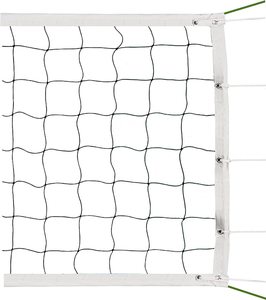(1919 products available)
















































































































































































































Volleyball net sizes vary based on the type of game and the level of play. There are several standards and specifications that define the dimensions of volleyball nets for indoor, outdoor, and beach volleyball. Here are the primary types:
Indoor Volleyball
According to FIVB (Fédération Internationale de Volleyball) standards, the indoor volleyball net size is 9.5 meters (31 feet, 10 inches) long and 1 meter (3 feet, 3 inches) wide. The height of the volleyball net is 2.43 meters (7 feet, 11.5 inches) for men and 2.24 meters (7 feet, 4.1 inches) for women. The width is consistent at 1 meter for both genders. The length of the volleyball net is 1 meter (3 feet, 3 inches) greater than that of the volleyball court.
Beach Volleyball
The volleyball court dimensions differ from the indoor version, although the net size is the same. According to FIVB, the beach volleyball net size is 8.0 meters (26 feet, 3 inches) long and 1.0 meters (3 feet, 3 inches) wide. The height of the volleyball net is 2.43 meters (7 feet, 11.5 inches) for men and 2.24 meters (7 feet, 4.1 inches) for women. The net is 1 meter (3 feet, 3 inches) wide, and its length is 9.5 meters (31 feet, 10 inches) on average.
Outdoor Volleyball
The dimensions for outdoor volleyball are the same as those for indoor volleyball. For casual play and recreational leagues, however, there may be some variations. Some leagues may choose a lower net height to accommodate younger players or recreational players of varying skill levels. The standards set by the FIVB and USAV provide guidelines for the dimensions of the volleyball court and the net, but local leagues, schools, and recreational centers might have their own adaptations.
Mini Volleyball
This version is played on a smaller court, usually 6m x 12m. The net height is lower, typically around 2.0 meters (6 feet, 7 inches) for both genders. The standard width of the volleyball net is maintained at 1 meter (3 feet, 3 inches).
Professional and Competitive Leagues
These leagues adhere strictly to the FIVB standards. The net size and court dimensions are regulated to ensure fair competition. The height remains at 2.43 meters (7 feet, 11.5 inches) for men and 2.24 meters (7 feet, 4.1 inches) for women.
Recreational Volleyball
In recreational settings, there may be variations in net height and court dimensions to accommodate players of different ages and skill levels. Some community centers and schools might use a lower net and smaller court to make the game more accessible.
School and Youth Volleyball
Leagues often use modified court sizes and net heights. For example, middle school players might use a net height of about 2.13 meters (6 feet, 11 inches), while elementary school players might use a height of around 1.8 meters (5 feet, 11 inches).
Understanding the different volleyball net sizes and their applications can help businesses better serve their customers' needs. Here are some key usage scenarios:
Professional Competitions
In events like the Olympics or FIVB World Championships, the standard men's volleyball net size (1.0 x 9.0 m) with a height of 2.43 m and the women's volleyball net height of 2.24 m is utilized. These nets are manufactured to precise specifications and are composed of high-quality materials to ensure durability and consistent performance.
Schools and Colleges
Institutions often use the standard indoor volleyball court dimensions and net sizes for their physical education programs and competitive sports. Additionally, some institutions may have outdoor facilities where different kinds of volleyball nets are used.
Recreational Facilities
Gyms, community centers, and sports clubs frequently install standard-height volleyball nets for indoor play. These places may also provide options for indoor and outdoor volleyball, accommodating various player preferences.
Beach Sports Complexes
Beach volleyball courts typically have a fixed height of 2.43 m for men and 2.24 m for women. These facilities are constructed with specialized volleyball nets that can withstand outdoor elements like sun and wind.
Backyard and Portable Sets
For casual players, families, and friends who enjoy playing volleyball in their backyard or at the park, portable volleyball net sets are popular. These sets often come with adjustable heights, allowing users to modify the net height according to their preferences.
Multi-Sport Facilities
Some sports complexes cater to various sports, including volleyball. These facilities may have adjustable volleyball nets to accommodate different types of volleyball games, such as men’s, women’s, and mixed-gender competitions.
Training Centers
Volleyball academies and training centers use regulation-sized nets to train athletes for competitive play. Consistent practice with the correct net size and height is essential for developing skills and ensuring players are prepared for official competitions.
It is essential for business buyers to know the different standards when buying volleyball nets for sale. Here are some standards that will help buyers stock products that are in demand.
Indoor Volleyball Games
As outlined, the regulation volleyball court dimensions are 18 meters long and 9 meters wide. The height of the volleyball net is 2.43 meters for men's volleyball and 2.24 meters for women’s volleyball. The volleyball net size should adhere to these standards to ensure proper indoor play. When buying volleyball nets, buyers should ensure they have a sturdy top cable and pole that can support the net and a bottom tension cord that helps keep the net tight.
Beach Volleyball
On the other hand, beach volleyball is played in a 16-meter by 8-meter court, which is smaller than the indoor court. The volleyball net height is 2.43 meters for men and 2.24 meters for women, similar to indoor volleyball. However, there are no physical barriers separating the two halves of the court. The net is supported by a post set outside the court. When buying volleyball nets, it is essential to have a durable that can withstand different weather conditions.
Volleyball Training
In addition, volleyball training has adjustable nets. These nets allow players to work on different skills and adjust their heights for various drills. The volleyball net size is perfect for coaches and players who want to focus on specific areas of their game. Also, portable volleyball nets are a great option for people who play volleyball for fun. The portable volleyball nets are simple to set up and take down.
The volleyball net size offers different features, which makes them more suitable for various playing conditions and skill levels. Here's a look at some common features, their functions, and the designs associated with them:
Material
Most volleyball nets are made from nylon or polyethylene. The materials make the netting durable and resistant to fraying and breaking. In addition, they can tolerate exposure to sunlight and extreme weather, which makes them ideal for outdoor and indoor use. The top and bottom sides of the volleyball net are usually reinforced with a thicker and sturdy fabric, which adds to the strength of the net. Also, it helps to avoid wear and tear. Some nets have a tarpaulin cover at the top; this helps to withstand tension from the poles and the impact of the weather.
Mesh Size and Thickness
The mesh size and thickness vary depending on the net's level of play and use. Professional volleyball nets have a mesh size of around 10 cm x 10 cm and a smaller mesh for increased precision and consistency. Recreational nets have bigger mesh, which allows for more flexibility and easier play. The thickness of the horizontal and vertical strands ranges from 3mm to 4mm. Thicker strands are more durable but less flexible, while thinner strands are more flexible but less durable.
Electroplated Steel
To make them last longer, some manufacturers coat steel poles with an electroplated finish. The coating will prevent rust and corrosion, which makes the poles ideal for outdoor use. In addition, these steel poles are heavy, which ensures that the volleyball net remains stable and secure during play.
Top Band and Side Bands
The top band on a volleyball net is usually thicker and more durable. In addition, it consists of multiple layers of material, such as nylon, polyester, or tarpaulin, which can withstand the tension of the pole and the impact of weather conditions. Side bands are sewn with heavy-duty thread and reinforced with thick fabric, which adds to the strength of the volleyball net. It also helps to endure the pulling and tugging from the wind and players during the game.
Wind Check Spheres
Volleyball nets have wind check spheres on the side; this helps to stabilize the net against wind. The spheres are attached to the net with a string, and a clip secures them in place. In addition, the wind check spheres lower the net's wind resistance, which prevents it from flapping or sagging in windy conditions.
Q1: What is the standard volleyball net size for various types of volleyball?
A1: The standard volleyball net size for indoor volleyball is 32 feet (9.75 meters) long and 3 feet (1 meter) wide. For men's competitions, the net height is 7 feet 11.6 inches (243 cm), while for women’s is 7 feet 4.1 inches (224 cm). The net is suspended horizontally above the court, dividing the two teams. It is supported by two vertical posts that are 10 meters (32.8 feet) apart. The distance between the posts and the net’s width is the same as the court’s width, ensuring that the net hangs properly in the middle.
Q2: What factors should be considered when choosing a volleyball?
A2: When choosing a volleyball, various factors should be considered. One important factor is the intended use of the volleyball. Different types of volleyballs are designed for different purposes, such as indoor play, beach play, or training.
Another factor to consider is the quality of the volleyball. Volleyballs range from recreational to professional quality. Recreational volleyballs are typically made of synthetic leather or plastic, while professional volleyballs have a top-quality composite leather cover for superior performance and durability.
The size and weight of the volleyball are also important factors. Standard volleyballs have a circumference of 65 to 67 centimeters (25.6 to 26.4 inches) and weigh 260 to 280 grams (9.2 to 9.9 ounces). However, there are smaller and lighter options available for children and youth players.
Q3: Are volleyball nets and balls universal?
A3: No, the volleyball nets and balls are not universal. They come in different sizes and dimensions depending on the type of volleyball being played. For instance, indoor volleyballs have different sizes than beach volleyballs.